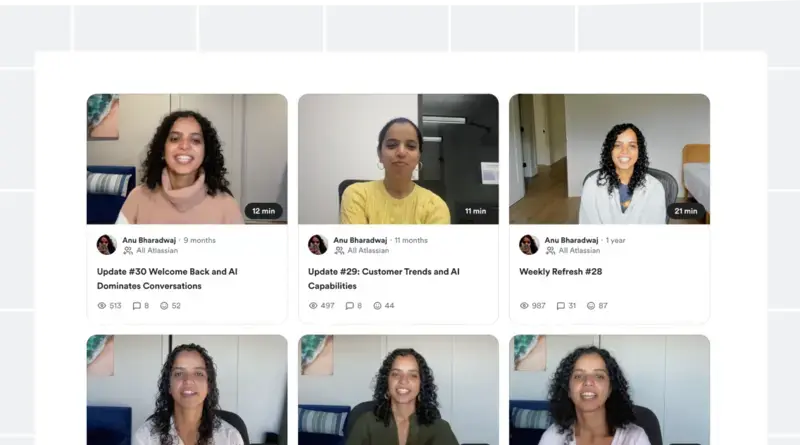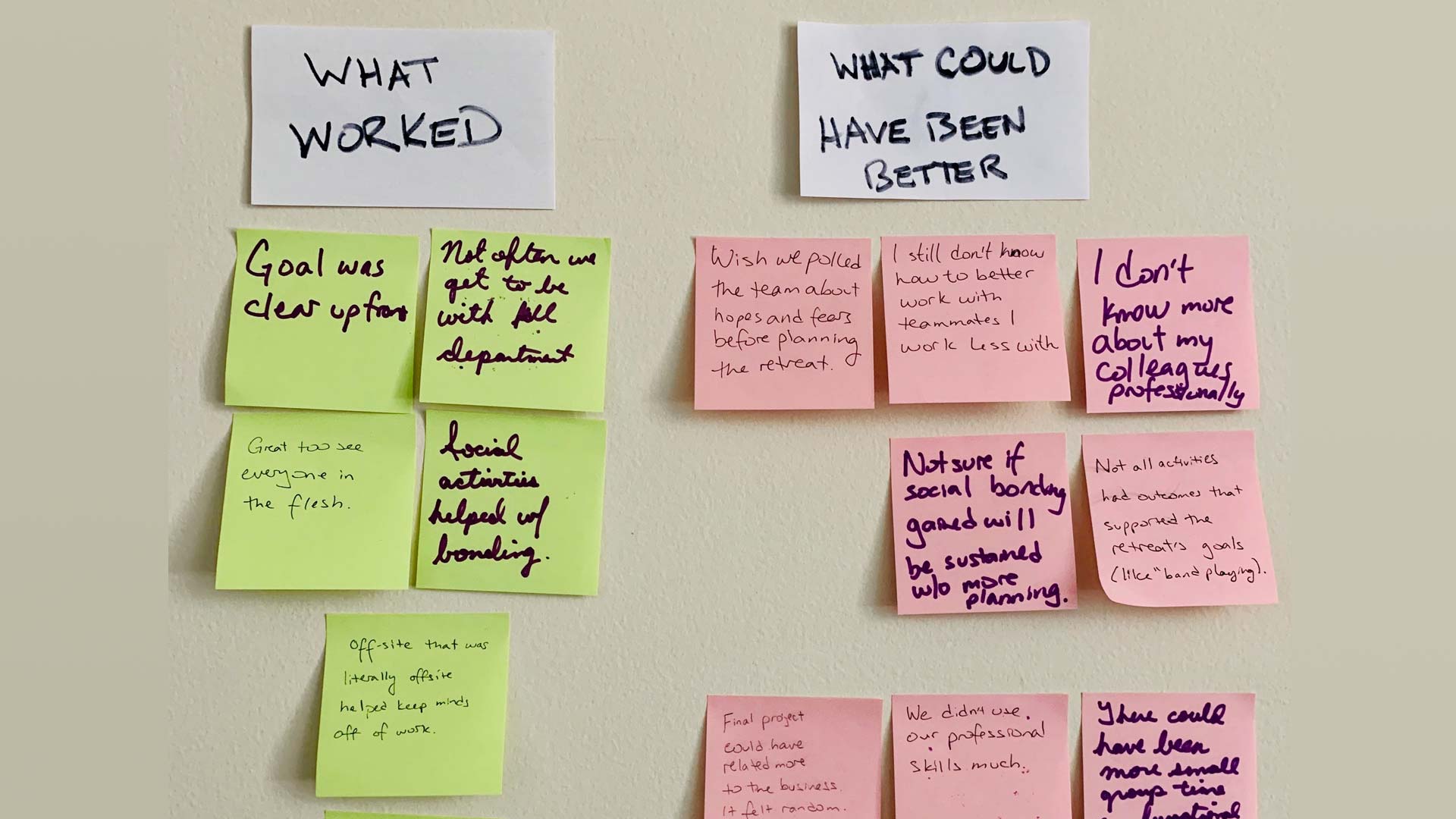Leader Top-of-Mind Updates
The more context teams have, the better they collaborate — especially during times of change. Make a big impact as their leader by sharing top-of-mind updates with the information they need to focus on what matters most.

PREP TIME
5m
Run TIME
60m
Persons
1
5-second summary
- Communicate to your team what matters most, and why.
- Create space for questions to clear up confusion.
- Keep the conversation going so priorities stay aligned with the work.
WHAT YOU WILL NEED
- Shared document (like Confluence).
- Video messaging tool (like Loom).
PLAY resources
How to share Leader Top-of-Mind Updates
Make a big impact as a leader by sharing top-of-mind updates with the information and context your team needs to focus on what matters most.
What are leader top-of-mind updates?
Leaders create top-of-mind updates, or a description of the goals, priorities, projects, updates, and contextual information that is “top of mind” for them.
What should the team be most focused on, and why? What information would help them feel clearer about what they’re working on, more confident, and more aligned with their collaborators?
That’s the type of information that could be included in a top-of-mind update.
Why run the Leader Top-of-Mind Update Play?
Imagine building a product without ever checking in with customers. Yikes. You’d miss crucial insights about their challenges — and how to solve them.
The same goes for our teams.
Top-of-mind updates keep teams agile, create space to raise concerns, spark discussions, and make sure our work stays aligned with the bigger picture.
Top-of-mind updates are not just nice to have. They’re crucial to helping teams thrive.
When should you create a top-of-mind update?
At a minimum, sharing updates on a monthly basis creates a regular cadence and a habit, with enough time in between to see progress and account for changes. If your organization or team is going through a period of change, more frequent updates will help them feel clearer and more comfortable about what’s happening and why.
3 benefits of top-of-mind updates
Research shows leader top-of-mind updates help:
1. Reflect
Est. time: 5 MIN
Before you create your first top-of-mind update, take a moment to reflect on a few questions:
- Who is a leader you admire for their communication? What makes their approach effective?
- How do you prefer for leaders to communicate with you?
- How might you adapt your style to your team’s wants and needs?
| Who's a leader you admire for their communication? What makes their approach effective? | |||
|
| |||
| How to you prefer to be communicated with? | |||
|
| |||
| Do you adapt your style to your audience or just default to your usual approach? | |||
|
|
Sample template for reflecting on your communication
Make time
Don’t expect to have time in your schedule for a top-of-mind update. Make time. Block 30–60 minutes on your calendar each month to create one.
2. Structure your monthly update
Est. time: 10 MIN
Use these prompts to shape your update. Keep it concise. Less is more!
What are we focused on?
List up to three priorities for the month. Add one or two sentences with details about each priority.
Why does it matter?
Connect the dots. Share your thoughts on why your team should care about those priorities and how each one connects to broader goals.
What now?
Tell the team explicitly what actions they should take next. If nothing changes, say so. If priorities have shifted, tell them why, and highlight trade-offs and/or dependencies.
What’s the headline?
Summarize your update in a punchy sentence or two. (Even though you’re drafting this now, it should appear at the top of your update.)
| Top 3 priorities: Explain each in 1-2 sentences. Be concise. | |||
| 1. 2. 3. | |||
| Why it matters: Why should your team care? How does this connect to broader goals? | |||
|
| |||
| What now? What actions should teams take? If nothing changes, say so. If priorities have shifted, highlight trade-offs or dependencies. Be explicit about how teams should respond. | |||
|
| |||
| TL;DR: Summarize your update in 1-2 punchy sentences. (Even though you're drafting it now, this should appear at the top of your Confluence page). | |||
|
|
Sample template to structure your Top-of-Mind Update
Share stories, not just information
Great communicators don’t just share information – they tell stories that draw their audience in. Through storytelling, leaders inspire purpose, build commitment, and foster resilience. Check out Atlassian Liz Fosslien’s LinkedIn class on storytelling to learn how to use stories to create purpose.
3. Bring your update to life with video
Est. time: 5 min
Using a video communication tool, like Loom, to record a short video (5 mins. or less) adds clarity and a personal touch since your team can see and hear you walk through the update. This is especially helpful when sharing big changes, serious news, and important announcements.
Once you record your video, add the link or embed the whole video at the top of your document.
Write a quick script
Gather your thoughts by writing a quick script or talking points before recording your video.
4. Share your updates consistently
Est. time: 2 min
Post the update in your team communication tool, such as a Slack or Teams channel. Try sharing updates around the same time each month (beginning or end, for example), in the same channel, and with the same amplification plan (asking direct reports to share with their teams, if applicable). This will help you make it a habit and set expectations with your team about when they can expect to hear from you.
5. Open up the conversation
Est. time: 5 min
When you share your update, start a feedback loop to keep teams engaged and in sync:
- Ask for comments and questions, and make it clear where or how people can respond.
- Spell out if you want people to take any action after reading or watching your update, like commenting on the page, replying to the message, sharing the update with others, etc.
- During your one-on-one meetings with direct reports, ask if they have any questions or feedback about your top-of-mind update, and how their teams are applying the information you shared (e.g., adjusting roadmaps, shifting focus, staying the course, or engaging key cross-functional partners).
- Re-engage by following up. You could add information to the shared document and/or post a message to the Slack or Teams thread with additional details, clarifications, feedback you’ve heard from direct reports, etc. Showing you’re listening is a small act that makes a big difference.
Feedback loops keep teams aligned, engaged, and in sync.
Encourage engagement: Explicitly ask for comments and questions — make it clear where to ask them.
Lean on your leaders: Ask your direct reports how their teams are applying your priorities — adjusting roadmaps, shifting focus, staying the course, or engaging key cross-functional partners.
Facilitate a conversation: Set a mid-month check-in — Loom updates work great to tee up deeper discussions in 1:1s or team meetings.
Follow up: Add a "What I Heard" section to your Confluence page, summarizing feedback and clarifications.
Re-engage: Drop a Slack message so teams know where to find the latest update
Sample checklist for starting a feedback loop
6. Reflect and adapt
Est. time: 2 min
After you’ve shared your update, discussed it with your team, and heard their feedback, assess what worked and what could be improved.
- What feedback did you get?
- What worked well?
- Did anything surprise you?
- What would you adjust next month? (messaging, delivery, both)
How can you enlist your direct reports to reinforce and amplify your update?
Then, iterate next time to continue improving communication and connection with your team. You’ve got this!
| What feedback did you get? What worked? What surprised you? | |||
|
| |||
| What would you adjust next month—messaging, delivery, or both? | |||
|
| |||
| How can you enlist your leaders to reinforce and amplify these priorities? | |||
|
|
Sample template for reflecting and adapting your Top-of-Mind Updates
Lather, rinse, repeat
Repetition isn’t redundancy — it’s reinforcement. The Rule of 7 says people need to hear the same message seven times in seven ways before they absorb it. Don’t hesitate to say it again. And again. and again!
Follow-up
Read up
Check out these books to level up your communication skills:
- Leadership Is Language: The Hidden Power of What You Say – and What You Don't by L. David Marquet
- Start with Why: How Great Leaders Inspire Everyone to Take Action by Simon Sinek
- Smart Brevity: The Power of Saying More with Less by Jim VandeHei, Mike Allen, and Roy Schwartz
- Crucial Conversations: Tools for Talking when Stakes are High by Kerry Patterson, Stephen R. Covey, Joseph Grenny, Ron McMillan, Al Switzler

Still have questions?
Start a conversation with other Atlassian Team Playbook users, get support, or provide feedback.
Other plays you may like
Culture
Team Health Monitor
Assess your team’s health and determine an improvement plan.
Meetings
Weekly Team Updates
Share how things are going—without scheduling another meeting.
Meetings
Page-Led Meetings
Better meetings start with a page that outlines the purpose, expected outcomes, and key discussion points.
Debrief
Retrospective
Provide a safe space to discuss what worked and what didn’t.
Stay up to date
Get the latest Plays and work life advice when you sign up for our newsletter.







